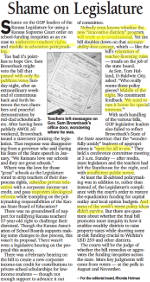Tag: Wichita Eagle opinion watch
-

For Wichita Eagle, no immediate Kansas budget solution
The Wichita Eagle shows how its adherence to ideology misinforms Kansans and limits their exposure to practical solutions for governance.
-

In election coverage, The Wichita Eagle has fallen short
Citizens want to trust their hometown newspaper as a reliable source of information. The Wichita Eagle has not only fallen short of this goal, it seems to have abandoned it.
-

Kansas sales tax reform: Revenue booster?
Kansas has a problem with sales tax exemptions, but the potential revenue boost from reform is not as great as commonly mentioned, unless Kansas wants to place its manufacturers at severe disadvantage.
-

Intrust Bank Arena: Not accounted for like a business
Proper attention given to the depreciation expense of Intrust Bank Arena in downtown Wichita recognizes and accounts for the sacrifices of the people of Sedgwick County and its visitors to pay for the arena. It’s a business-like way of accounting, but a well-hidden secret.
-

Shame, says Wichita Eagle editorial board
The Wichita Eagle editorial board rebukes the Kansas Legislature.
-

In Kansas, the Blob is worked up
In Kansas, we’re seeing the Blob at full activation, vigorously protecting its interests against school reforms.
-
What is the import of the farm bill to Kansas?
Correcting the Wichita Eagle’s facts will place the importance of the farm bill to Kansas in proper perspective.
-
Joseph Ashby on local news media, anti-conservative bias
On the Joseph Ashby Show, the host commented on Wichita news media, and drew some conclusions about anti-conservative bias in Wichita news media.
-
Ending the Economic Development Administration
U.S. Representative Mike Pompeo has introduced legislation to end the Economic Development Agency, which he describes as a “politically motivated federal wealth redistribution agency.”